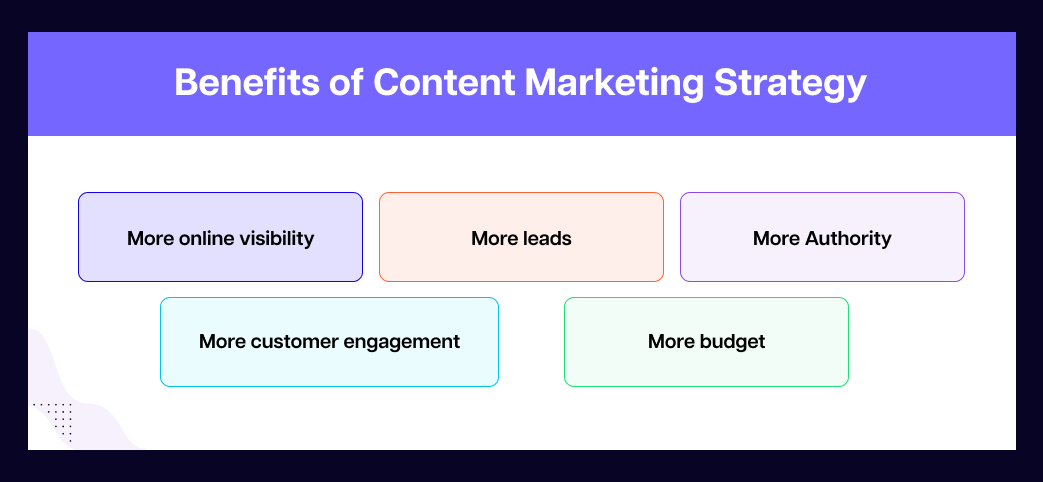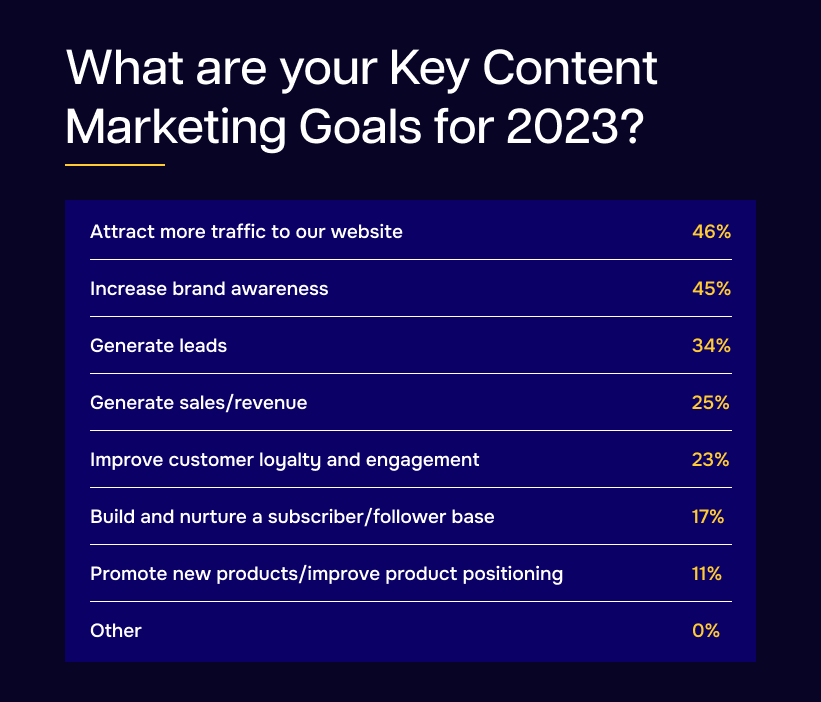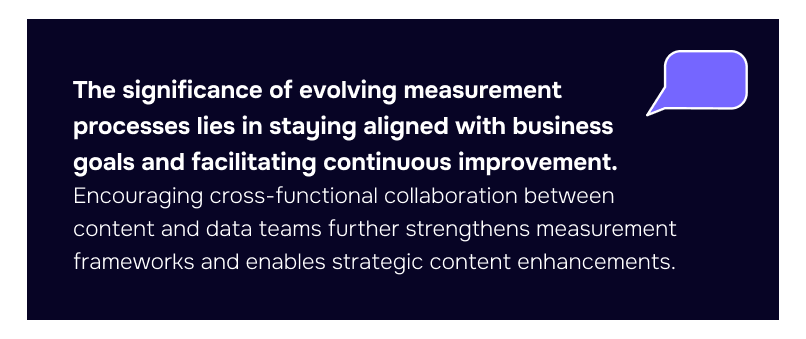How to Measure Content Marketing Effectiveness

In today’s dynamic landscape, high-quality content and effective content marketing are essential for businesses to thrive. It’s one of the best ways to consistently engage with your audience while enhancing your reputation and credibility.
The Content Marketing Institute (CMI) defines content marketing as “a strategic marketing approach focused on creating and distributing valuable, relevant, and consistent content to attract and retain a clearly defined audience — and, ultimately, to drive profitable customer action.“
Hence, the need to produce content for both potential and repeat buyers has intensified. In fact, 54% of B2B decision-makers invest over an hour each week in reviewing thought leadership content. In addition, almost 50% of buyers consume three to five pieces of content before initiating a sales process, and 96% of B2B buyers evaluate thought leadership before purchasing.
Keeping this in mind, it is no surprise that nearly 50% of companies plan to expand their content teams, with positions such as content creators, content marketing managers, and content strategists at the forefront of recruitment efforts.
However, amid this surge in content creation, the challenge for brands lies in breaking through the saturation and effectively reaching their target audience. The high content volume necessitates strategic approaches to ensure visibility and resonance in an increasingly crowded digital landscape.

But you need to remember that having a strategy alone isn’t enough. To be truly effective, you need to measure how well your content is doing. For example, 95% of the top marketers use data to measure the performance of their content. In comparison, 83% of them have set key performance indicators (KPIs), and 67% measure how much profit they’re making from their content marketing efforts.
Having said that, let’s look at what KPIs you should be measuring to ensure that your content marketing strategy is successful.
Understanding Key Performance Indicators (KPIs)
As mentioned before, KPIs play a key role in gauging the effectiveness and impact of campaigns, strategies, and overall marketing initiatives. By establishing and tracking specific KPIs, marketers gain insights into their performance, enabling data-driven decision-making. These metrics help answer crucial questions about the efficiency of marketing activities, audience engagement, and the return on investment (ROI) for various campaigns.
KPIs are not one-size-fits-all; they are highly adaptable and should align with a company’s unique strategy and objectives. Different companies may prioritize distinct KPIs based on their industry, target audience, and business goals. Here are examples of how KPIs can vary:
Lead Generation and Conversion Rates
If the primary goal is to increase leads, KPIs may focus on metrics such as lead conversion rates, lead acquisition cost, and the number of qualified leads generated. Alternatively, a company focused on e-commerce like Amazon might prioritize KPIs like conversion rates, average order value (AOV), and customer lifetime value.
Brand Awareness and Engagement
A company aiming to enhance brand awareness might emphasize KPIs such as social media impressions, brand mentions, and click-through rates on branded content. On the other hand, a tech startup may prioritize KPIs related to website traffic, user engagement, and download/installation rates for their app.
Customer Retention and Satisfaction
A subscription-based service such as Netflix or Prime Video may focus on KPIs like customer churn rate, customer lifetime value, and Net Promoter Score (NPS) to assess satisfaction and retention. A service-oriented business may focus on client satisfaction surveys, customer feedback response rates, and renewal rates.
Metrics for Different Marketing Channels
Is your content marketing effective? Evaluating the success of your content initiatives involves diving into specific metrics tailored to different marketing channels.
Let’s explore key indicators across various platforms to gauge the impact and optimize your content marketing strategy:
Social Media Marketing Metrics
Social media platforms are powerful tools for brand exposure and engagement. To measure the effectiveness of social media marketing efforts, you need to look at your follower count – a fundamental metric that indicates the growth and engagement of your social media audience.
Beyond this, assess engagement rates, likes, comments, and shares relative to your follower base. A high engagement rate indicates that your content resonates with your audience, fostering community interaction. For a more comprehensive view, measure the conversion rates, tracking the percentage of users taking desired actions, such as making a purchase.
Content Marketing Metrics
Content marketing involves creating and distributing valuable content to attract and retain a target audience. Metrics for assessing content marketing effectiveness include:
-
Website Conversions: Monitor the number of visitors who complete a desired action on your website, such as making a purchase or signing up for a newsletter. For example, tracking the conversion rate from blog posts to product pages indicates the content’s influence on purchasing decisions.
-
Video Engagement: Evaluate metrics like views, watch time, and engagement (likes, comments, shares) for video content. High engagement and prolonged watch times signify that your video content resonates with viewers.
-
Traffic Metrics: Analyze website traffic generated by content marketing efforts. An increase in organic search traffic or referral traffic from content-driven sources indicates effective content in attracting visitors.
Email Marketing Metrics
Email remains a powerful and direct communication channel. Is your email marketing making the desired impact? Start by assessing delivery rates and ensuring your emails reach recipients’ inboxes. Open rates provide insights into how engaging your email content is, while click-through rates (CTR) reveal the percentage of recipients acting on your email’s call-to-action. These metrics collectively dictate the effectiveness of your email campaigns.
Monthly and Weekly Tracking
Consistent and regular tracking of content marketing metrics is essential for optimizing strategies and identifying trends and performance. Establishing a routine schedule for both monthly and weekly tracking ensures that you stay informed about your content’s impact and make timely, informed decisions.
Simultaneously, consistent tracking confirms that your content efforts align with broader business goals. By regularly assessing performance against predefined KPIs, you can validate whether your content is contributing to overall business objectives.
Tools and Methods for Data Collection and Analysis
-
Google Analytics: Use Google Analytics for comprehensive insights into website traffic, user behavior, and conversion metrics. Set up custom dashboards to track specific content-related KPIs over time.
-
Social Media Analytics Platforms: Leverage built-in analytics tools on social media platforms (e.g., Facebook Insights, Twitter Analytics) for tracking follower growth, engagement rates, and post-performance. Consider third-party tools for consolidated reporting across multiple channels.
-
Email Marketing Analytics: Platforms like Mailchimp, Constant Contact, or HubSpot provide detailed email marketing analytics. Monitor open rates, click-through rates, and subscriber growth weekly and monthly.
-
Content Management Systems (CMS): CMS platforms like WordPress often have built-in analytics features. Monitor page views, time on page, and user interactions to assess the performance of your blog content.
-
Project Management and Collaboration Tools: Use tools like Asana or Trello to track content creation workflows. These tools can help ensure that content is produced and published according to the established schedule.
-
Excel or Google Sheets: Create custom tracking sheets to consolidate data from various sources. This manual approach allows for flexibility and customization based on specific metrics relevant to your content marketing goals.
Setting and Tracking Marketing Goals
Before creating content, you need to be clear about what you want to achieve. Here’s how to get started:
-
Consider your company’s business and marketing objectives. Whether aspiring to be the top solution for time management or aiming for a specific revenue target, your content goals should align with these broader ambitions.
-
Reflect on how your content can contribute to achieving these significant business goals. Ask yourself what type of content will attract and engage new users.
-
Identify the content marketing metrics that truly matter to your objectives. What does success look like in quantifiable terms? Establish specific success metrics for each piece of content you plan to create and share.
Consider both primary and secondary metrics for each goal. Primary metrics could include revenue generated by content marketing, organic traffic, and the number of leads. Secondary metrics might encompass rankings and social media shares, providing additional layers of insight.
To set a benchmark, look into your Google Analytics dashboards. Analyze how your existing content has been performing against the established goals. This analysis provides valuable insights into areas of strength and opportunities for improvement.
According to current trends, attracting traffic, enhancing brand awareness, and generating leads remain focal points in content marketing for 2023.

However, these goals may differ based on your industry, company size, and other factors.
While SMART (Specific, Measurable, Achievable, Relevant, and Time-bound) goals offer a structured approach to goal-setting and measurement, the CLEAR framework provides a more adaptable alternative, especially in agile and fast-changing environments.
CLEAR goals are evaluated based on the following principles:
-
Collaborative: Encourages teamwork by fostering a collaborative approach to goal attainment.
-
Limited: Constraints are inherent in CLEAR objectives, both in terms of scope and duration.
-
Emotional: Infuses a sense of inspiration and motivation into your team.
-
Appreciable: Breaks down into smaller, more manageable micro-objectives.
-
Refinable: Recognizes the need for adaptability.
Analyzing and Reporting Data
Analyzing and reporting data is a critical phase in the content marketing cycle, offering valuable insights into the impact of campaigns.
Here are strategies for organizing and presenting data effectively to stakeholders:
-
Define Objectives: Clearly outline what insights you seek to guide data analysis.
-
Choose Relevant Metrics: Focus on metrics aligned with content marketing goals for meaningful reporting.
-
Visualize Data: Use clear and relevant visualizations to simplify complex data for stakeholders.
-
Craft a Compelling Story: Structure your report as a narrative, providing context and coherence to the data.
-
Segment Data for Deeper Insights: Break down metrics by demographics, geography, or content types for deeper understanding.
Here are tips for creating insightful content marketing reports:
-
Focus on KPIs: Center reports around key performance indicators to showcase campaign success.
-
Include Comparative Analysis: Provide benchmarks and comparisons for context and reference.
-
Highlight ROI and Conversions: Clearly demonstrate the return on investment and tangible outcomes of content marketing efforts.
-
Showcase Engagement Metrics: Emphasize metrics like time spent on pages and social interactions to illustrate audience engagement.
-
Incorporate Customer Feedback: Include testimonials and feedback for authenticity and qualitative insights.
-
Provide Actionable Recommendations: Conclude with practical suggestions for continuous improvement and future strategies.
Measuring Long-Term Content Marketing Effectiveness
Evaluating the impact of content marketing over the long term goes beyond immediate metrics, emphasizing the tracking of customer retention rates and sustained engagement.
Customer retention rates act as key indicators of brand loyalty, signaling that content resonates with the existing audience and contributes to cost-effective marketing strategies. High retention not only ensures the loyalty of current customers but also maximizes their lifetime value.
Similarly, long-term engagement is important for establishing brand authority, building trust, and adapting to customers’ evolving needs throughout their lifecycle. It creates opportunities to transform satisfied customers into brand advocates, fostering organic growth through positive word-of-mouth referrals.
On the other hand, continuous marketing efforts are essential for both new and existing customers. While acquiring new customers is important, nurturing existing relationships through ongoing engagement prevents attrition and builds loyalty. Regular content creation also allows brands to adapt to industry changes, expand reach, and iterate strategies based on data-driven insights.
Effective Content Marketing Tips for Measuring Metrics and Best Practices
To ensure content marketing effectiveness, it’s crucial to implement measurement tips and best practices that go beyond surface-level metrics. Tracking conversions and collecting actionable metrics are key elements in this process.
The first step is clearly defining conversion goals aligned with broader business objectives. Utilizing conversion tracking tools like Google Analytics provides accurate insights into user actions, allowing for precise measurement of content impact.
Additionally, monitoring micro-conversions, such as engagement metrics, provides an in-depth understanding of user behavior, contributing to a more comprehensive measurement strategy. Implementing UTM parameters in URLs further enables granular analysis of the effectiveness of different marketing channels.
Evolving measurement processes are equally important. In that case, adopting agile approaches ensures that measurement strategies stay aligned with evolving business goals and market trends. Leveraging A/B testing allows for comparing different content variations and refining the content strategy for maximum impact.
Tools like heatmaps and user journey analysis provide visual insights into user interactions, facilitating optimized content placement and design. Investing in advanced analytics platforms enhances the depth of insights into user behavior, content performance, and audience demographics, enabling data-driven decision-making for ongoing content optimization.

Advanced Analytics Techniques
Measuring content marketing ROI requires advanced analytics methods that go beyond traditional metrics. Here are some of the advanced analytics techniques that can help you measure content marketing effectiveness.
-
Attribution Modeling: Implement advanced attribution models to attribute conversions accurately. Multi-touch attribution methods—including linear or time decay models—take into account the complete customer journey, offering a more comprehensive view of content impact.
-
Customer Lifetime Value (CLV) Analysis: Evaluate the long-term value of customers gained through content marketing efforts. CLV analysis considers immediate transactions and the ongoing value a customer brings, providing a holistic ROI perspective.
-
Incrementality Testing: Conduct A/B tests to determine the incremental impact of content marketing. By comparing a group exposed to content against a control group, incrementality testing helps isolate the true effect of content efforts on desired outcomes.
You can also integrate artificial intelligence (AI) for enhancing insights with predictive analytics for forecasting, personalization algorithms for tailored content experiences, and sentiment analysis for real-time adjustments based on audience reactions. Here’s how:
-
Predictive Analytics: Leverage AI-driven predictive analytics to forecast future content performance. By analyzing historical data, AI models can predict trends, allowing marketers to optimize strategies for maximum impact proactively.
-
Personalization Algorithms: Use AI algorithms for content personalization. By understanding individual user preferences and behavior, AI helps deliver tailored content experiences, enhancing engagement and conversion rates.
-
Sentiment Analysis: Deploy AI-driven sentiment analysis to gauge audience reactions. Understanding sentiment around content allows for real-time adjustments and ensures that campaigns align with audience preferences.
Tools like advanced Google Analytics features, marketing automation platforms, and social media listening tools further contribute to detailed insights.
These advanced techniques empower marketers to measure ROI effectively and optimize content strategies for tangible business outcomes in the ever-evolving digital landscape.
Wrapping Up
As we have seen, measuring content marketing effectiveness is crucial for sustained success. Comprehensive strategies involving tracking conversions, analyzing actionable metrics, and evolving measurement processes are key to ensuring that your content marketing efforts are effective and yield tangible business outcomes.
Looking for high-quality writing services? Look no further because Pepper Content is here to take care of all your content needs. Contact us today to ace the marketing game.
Latest Blogs
Learn how to rank on AI search engines like ChatGPT, Perplexity, and Gemini by optimizing your content for authority, structure, and relevance. Stay ahead in AI-driven search with this strategic guide.
Explore the best healthcare SEO services for your medical practice. Improve online visibility and effectively reach more patients in need of your services.
Discover top social media agencies specializing in banking solutions, enhancing financial services and driving engagement.
Get your hands on the latest news!
Similar Posts

Content Analytics
5 mins read
How to Check Google Rankings: 3 Swift and Accurate Methods

Content Analytics
5 mins read
A/B Testing in Content Marketing: Uncovering What Works Best for Your Audience

Content Analytics
7 mins read